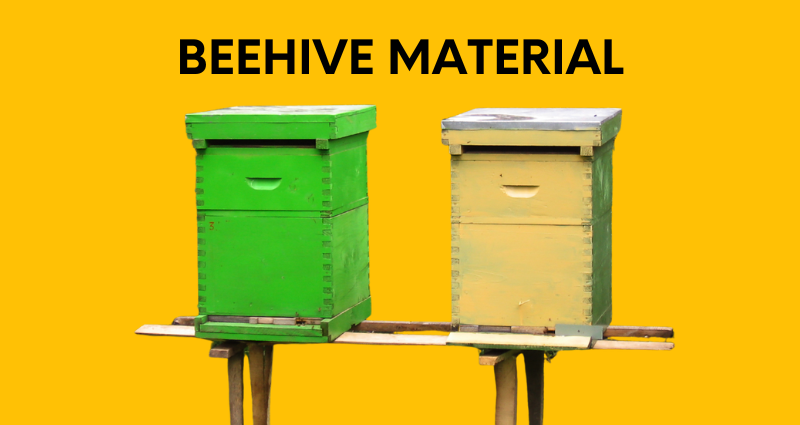Mordern manmade beehives are made from wood frames filled with wax honeycomb cells for storing honey, pollen, and larvae. The most common types of wood used to create bee hives are cedar, cypress, pine and poplar.
Beehive Material
Traditionally, manmade beehives are constructed from cedar wood or cypress since these woods are naturally rot-resistant and provide superior insulation against the elements. Pine and poplar may also be used to make the frames and foundational pieces of the hive. The wooden, vertically hung frames provide a place for the bees to attach their wax combs.
Many beekeepers also use wire mesh or strips along the roof area for further protection from wind or rain. Inside, the frames contain a thin wax foundation panel used as a base on which bees build their combs. Finally, an entrance reducer creates a single entrance to the hive population that can control who goes in and out.
To form beehives out of wood, beekeepers use interlocking joinery techniques such as tongue-and-groove or finger joints that provide a secure fit between the various components within a hive. Craftsmanship is vital for delivering airflow points within the hive while allowing bees to protect the interior with insulating waxes or propolis.
Some beekeepers choose alternative materials, such as plastic. Plastic options include pre-fabricated models or sheets of engineered acrylic to create vertical top bar hives or moveable frame hives. While these materials are typically more lightweight than wooden equivalents and easier to assemble, they may not last as long.
How Do Bees Make The Hive?
Honey bee hives have hundreds of hexagonal shape wax cells, each filled with liquid honey or larvae. How do honeybees create these hexagon cells? They make their own wax!
Worker bees secrete wax from eight special glands on their abdomen and use it to create brood cells where the queen will lay eggs. This wax then hardens into six-sided cells protecting the queen bee and her larvae.
The process starts with a pattern of tiny round dots etched onto a flat surface. The worker bees then fill the areas between these dots to form adult-sized hexagonal cells. The number of sides depends on which life stage they’re building a cell for: larvae cells have nine sides, while honey cells have six.
The cells take their hexagonal shape as each layer is added. The result is an enclosed unit to hold honey or a growing pupa for day-to-day activities.
Every cell reflects incredible symmetry and uniformity through the engineering of thousands of tiny bee bodies. Thanks to their diligent work, beekeepers can enjoy one of nature’s most magnificent treats without worrying too much about maintenance or upkeep.
Bee Hive vs. Bee Nest
There is a distinct difference between bee hives and bee nests.
Bee hives are manmade. Bees make bee nests in the wild.
Bee hives are built from pre-fabricated parts that form a box-shaped structure. It houses the frames that a honey bee colony will build its honeycomb on. The components of a beehive serve as cell frames or combs with perforations to hold honey or pollen. These frames slide into the box to mimic the interior architecture of a natural hive.
Bee nests consist of raw, natural materials collected and assembled by the bees. They are typically made with leaves and plant resins, with coarser materials like bark used as a binding agent and as support and insulation for the worker brood cells. Beeswax helps stimulate cell growth when used to create hexagonal larvae cells inside the nest while providing rainproofing on the nest’s exterior.
Where Do Bees Make Hives
Natural bee nests are built in sheltered crevices like hollow trees or large cavities in rocks or logs.
Manmade bee hives built to increase honey production or as part of conservation efforts can be placed just about anywhere since the covered boxes offer protection from the elements.
Still, general guidelines for apiaries or bee yards (a location where bee hives are kept) include:
- Avoiding hills and valleys
- Providing protection from the wind
- Placing the hive in an area with plenty of sunshine (not under shady trees)
- Ensuring there’s a food and water source nearby
Frequently Asked Questions
What are honey supers?
In manmade bee hives, a honey super is an additional box placed above the box with brooding cells that allows bees to store surplus honey.
What is the benefit of using wood to build a bee hive?
Wooden beehives are durable and long-lasting, but more importantly, bees tend to more readily accept natural wood. Depending on the type of wood you choose, it also naturally rots- and pest-resistant, and can even be painted to give your bee yard some flair!
What is a Langstroth beehive?
A Langstroth hive is a manmade beehive constructed of stacked boxes containing vertically hung frames that are removable to harvest honey. Bees will build a new hive on the frames using secreted beeswax to create the hexagonal cells that house honey and larvae.

